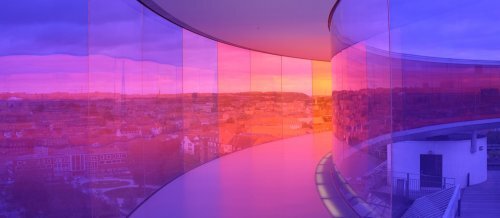Transparent self-cleaning coatings powered by sunlight
Photocatalytic technology converts light into chemical energy. Transparent photocatalytic thin films hold great potential in the development of self-cleaning surfaces, but suffer from a poor visible light response that hinders the use of natural sunlight. As a solution the film is modified with plasmonic nanoparticles that act as thousands of visible light antennas. The DuEL group at the University of Antwerp has developed a new method to embed such structures in the catalyst matrix to fully exploit this effect. These self-cleaning coatings can play a role in air and water purification, self-cleaning glazing (e.g. for construction, solar panels...) and antibacterial surfaces.

( Picture: ARoS Aarhus Art Museum - via Pixabay)
Situation before
Photocatalytic coatings for self-cleaning applica-tions are usually deposited as a thin film that is capable of removing pollutants from the surface using light. This photocatalytic layer most often consists of titanium dioxide (TiO2). TiO2 thin films can be deposited by a wide variety of methods such as target sputtering, thermal methods, vapor deposition techniques, anodic oxidation and plasma-assisted deposition processes. These strategies, however, require expensive and dedicated equipment. In addition, the main constraints of photocatalytic self-cleaning materials on the market, is their limited solar-light response. Photocatalytic films solely based on TiO2 as the active component can only be activated by UV-light, that accounts for only 4% of the entire solar spectrum.
Technology
Plasmonic metal nanoparticles that efficiently interact with visible light are prepared with full control over the particle properties. Next, they are made compatible with a low-cost TiO2 sol-gel coating protocol, resulting in a one-pot coating suspension. After applying this suspension on a substrate followed by an annealing step, homogeneous and transparent thin films are obtained. Since the plasmonic effect is confined to the nanoparticles surface, embedment of such particles in the catalyst film ensures that the effect is fully exploited, as opposed to particles loosely deposited on the film surface. Cost-effectiveness analysis has shown that particle loadings as low as 1 wt% offer an economically attractive route to self-cleaning glass that outperforms commercially available benchmarks.
Partners we search for
Glass manufacturers for the construction sector (e.g. domestic glazing, glazing for office spaces, skyscrapers settings in particular), photovoltaic manufacturers or end users who want to add the extra feature of a self-cleaning top-layer, producers of catalysts to assist in the upscaling process, …
About the researchers
The DuEL group, founded by Prof. Silvia Lenaerts in 2009, is located at the bioscience engineering department of the University of Antwerp and focusses on sustainable energy, air and water technology in a broad sense. Solar energy utilization and air purification are two of the most dynamic central research themes. Over the last five years the team has built up extensive knowledge on plasmon-enhanced photocatalytic technology under the lead of Prof. Sammy Verbruggen and Prof. Silvia Lenaerts.
IP position
A patent is pending for this technology (PCT/EP2018/079983)